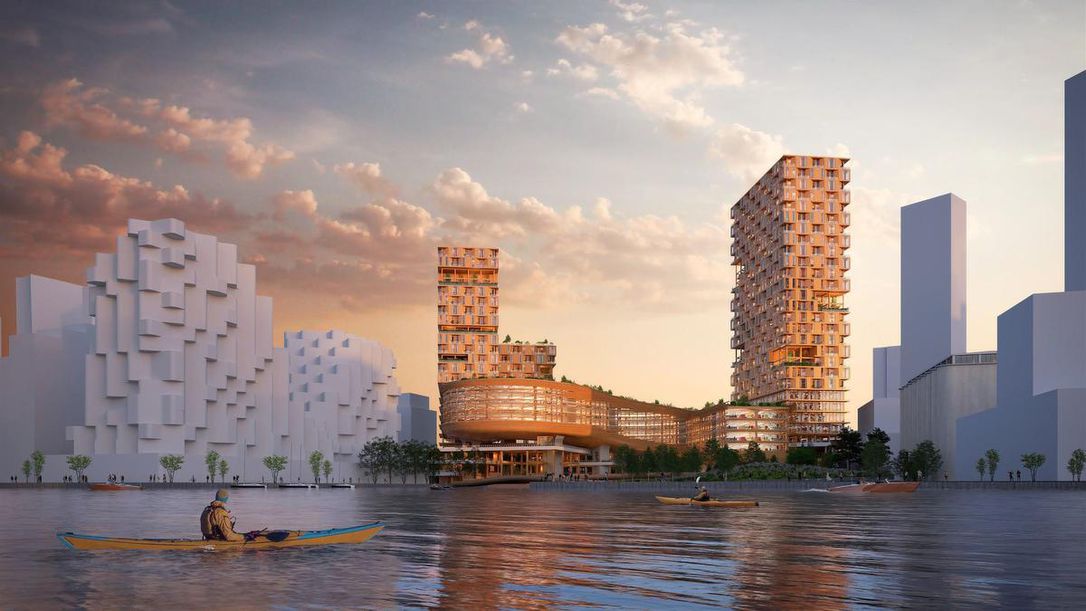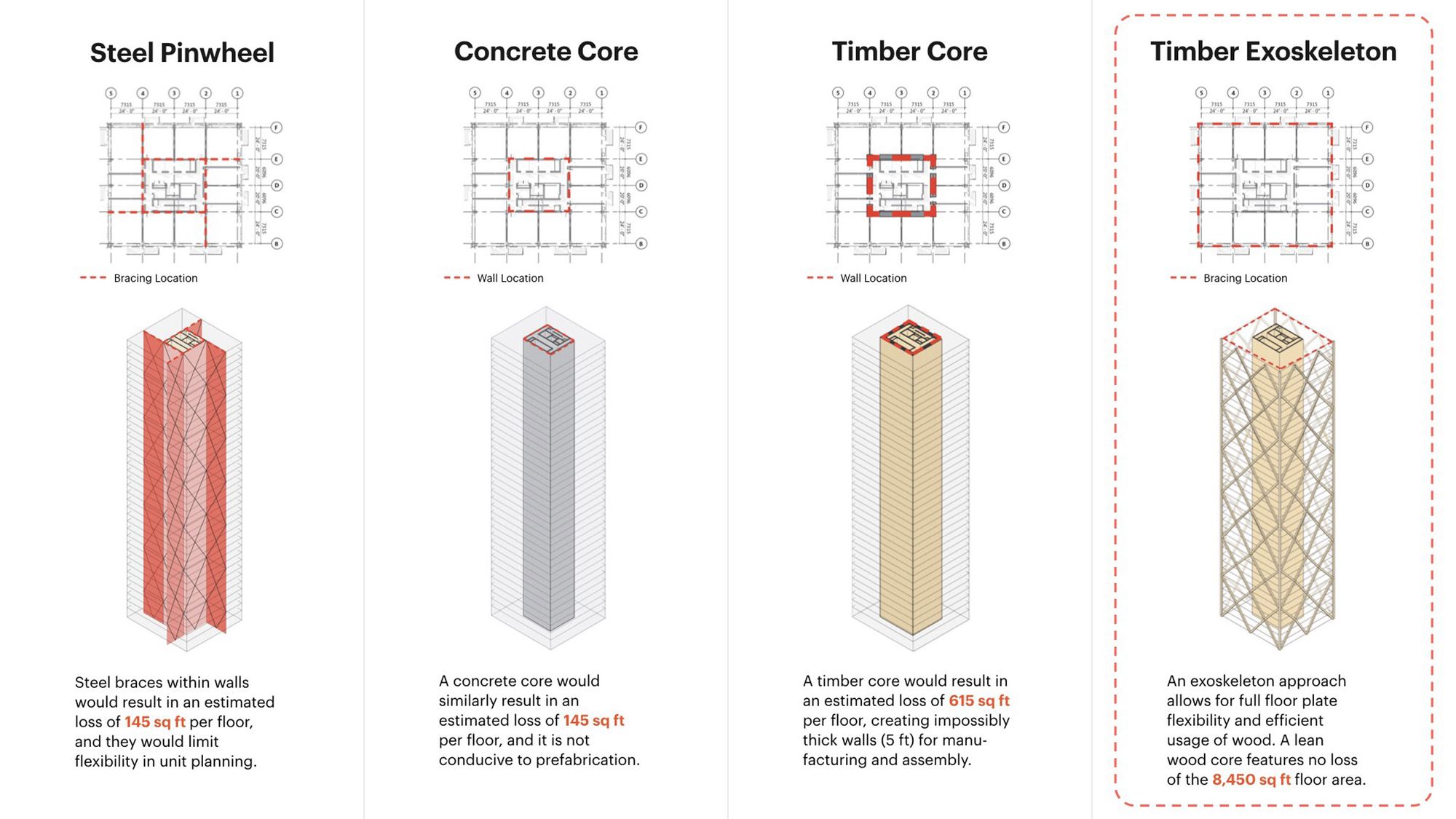There's a lot of enthusiasm about wood buildings, partly because it's seen as some as a new or and others as an old or classic construction material, and mainly because people believe there is a sustainability benefit. This is a quick explainer of the pros and cons.
What people mean in the built sector by 'wood building', at the moment, is not particularly buildings with wooden facades and surfaces, but buildings with wood structure. To this extent, we are talking about 'mass timber' not wood panels or tiles.
'Mass timber' is short for massive timber and as the name implies, it means wood elements that have a massy character: suitable for structure, in other words.
Mass timber for modern construction is mainly not, however, solid wood—planed blocks of giant tree trunks. It's engineered wood, constructed from smaller pieces. The main ways in which mass timber is engineered include:
- Glulam: strips of wood glued together in layers, in the same orientation as the grain of the wood
- Cross-laminated timber (CLT): strips wood, often shorter than those in glulam, glued together in layers that are perpendicular from each other
- Laminated veneer lumber (LVL): thin strips of wood veneer, glued together to create a structural-quality element.
There are other types of engineered mass timber and the technical evolution is picking up speed as the market responds.

Environmentally, the obvious environmental concerns - toxic chemicals from glue - are not fully resolved, but clearly in focus in the production process. What is really at stake is how much mass timber can help with the climate problem. Here's where confusion creeps in.
It is true that wood 'sequesters' carbon dioxide - takes it out of the atmosphere, converts it and stores it as wood fibre. However, the big math is simple: wood itself doesn't last for ever, so however much you think you can sequester, it's going back into the atmosphere one day.
It's also important to get the detailed math right. It's not always clear how much carbon a given forest or wood type sequesters. And in any case, it's not correct to buy wood that wasn't planted for sequestration purposes, and then count it as if sequestering new carbon: it sequestered carbon emitted previously.
But this debate - which is the main debate on the sustainability value of mass timber - is a distraction from the bigger opportunity. Mass timber:
- doesn't generate much carbon during production
- displaces significant carbon generated by its alternative in construction, steel and concrete
- is more renewable than current concrete mixes, because limestone is finite
The missing piece is the quality of the forestry resource underlying the growth in mass timber. Just planting trees for lumber, as nice as it may sound, is not at all an environmental strategy in itself: plantations can replace priceless ancient forest stands and associated biodiversity, require massive chemical inputs, and otherwise make landscapes fully inhospitable.
So: if forestry for mass timber supports old growth and biodiversity, manages and reports its carbon impacts including sequestration, supports good practices downstream in the lumber and construction sectors, mass timber is a very promising lower-carbon construction target.
But: construction of what? The weakest or at least least clear arguments for mass timber as a sustainable construction material are about its applicability modern construction. Concrete and steel have pioneered tall buildings for a century, wood is just starting out.
In London alone in 2019, 541 buildings more than 20 stories were planned or under construction. The tallest wood building in world currently, Mjøsa Tower, is 18 stories high.
The comparison is not flattering, even if there plans for more 20+ stories wood buildings, even up to 80 stories. Engineered wood mass timber does have serious engineering features: including maybe surprising ones like high fire and earthquake resistance. And it is both denser and in some formats stronger than concrete, meaning it ought to have a promising future.
But it has a long way to go, in an industry that has brought housing to the world largely through the miracle of concrete and steel. Even in the Mjøsa Tower, concrete was used for the foundations, first and upper stories.

The main challenge with replacing concrete and steel with mass timber may not even be the structural limitations.
For example: are potential benefits to modular construction, pre-constructed parts assembled on site. But pouring concrete, particularly for complex and large buildings is maybe irreplaceable for its flexibility and logistical efficiency.
Where does that leave the sustainability potential of mass timber? In a good place, but less dramatic, at least today, than some may think.
The greatest sustainability benefit in fact may be very different from avoided carbon emissions, sequestration and potential support for better forestry. It may be in changing how we think about resources, and how we live.
What the current images of mass wood buildings, partly because associated with high-tech and ambitious partners, have done is firstly start the process of reacquainting people with wood-rich living and working environments: the exposed wood elements, and the associated awareness of the forest behind the wood, are a story about resources, and their sources, and a meaningful if abstract reconnection to nature than many welcome.
Maybe it's a short-term effect of relative novelty. But if not, it could be one of the most powerful ways to educate people about resources and the natural world: daily reminders that whether it's wood, steel, limestone it all comes from somewhere, goes somewhere, and has an impact.
Here's maybe the biggest implication of mass timber, though: a new wave of low-rise density. There is a reason that buildings have gotten so tall, and it's not mainly because rich people like living high up. It's patterns of land use and technology, that often aren't even combined with great density. Famously, Paris, with all its mid-rise buildings, is more dense than New York.
If wood cannot build very high very soon, maybe that's exactly what we need: an opportunity to plan for mid-rise development, that requires and exploits good land use rules and patterns to achieve density without high rise. Sustainability, at the urban scale, is about density and that doesn't need high-rise.
This may be biggest opportunity for mass timber: supporting an efficient spatial morphology, without requiring higher engineering specs.


